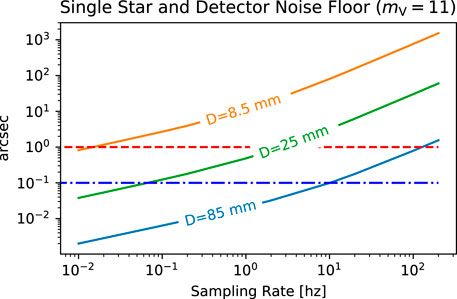Corrigendum: Practical limits on nanosatellite telescope pointing: The impact of disturbances and photon noise
- 1Department of Astronomy/Steward Observatory, Tucson, AZ, United States
- 2The Robotics Institute, Carnegie Mellon University, Pittsburgh, PA, United States
A Corrigendum on
Practical limits on nanosatellite telescope pointing: The impact of disturbances and photon noise
by Douglas ES, Tracy K and Manchester Z (2021). Front. Astron. Space Sci. 8:676252. doi: 10.3389/fspas.2021.676252
In the original article, there was an error in Figure 6, page 5, as published. The arcsec of the pointing error was much higher for each aperture as a function of the sampling rate. This is because the figure included a 10× larger number of pixels contributing noise and a more conservative numerical approach to calculating the centroid error, which also includes sampling errors, resulting in generating the erroneous figure. The figure was inconsistent with the published, analytic approach and the released code (Douglas et al., 2021a). However, the figure is correct in the arXiv preprint (Douglas et al., 2021b). The corrected figure appears below.

FIGURE 6. Attitude sensing limit curves assuming centroiding noise due to photon statistics and detector noise from the TRL-9 MT9P031 CMOS detectors widely used on nanosatellites. For an 85-mm space telescope, sub-arcsec sensing is readily achieved at 100 s sampling or slower rates, implying that ∼10 Hz bandwidth controllers are as fast as is feasible on dim stars.
In the original article, the area of the telescope was erroneously printed as (Dx/2)2π. It should be given as
A correction has been made in section 2 METHODS, 2.3. Sensing, paragraph 4, page 5. This sentence previously stated:
“The étendue is defined as the product of the collecting area, π(Dx/2)2, and the solid angle, Ω, subtended by the instrument.”
The corrected sentence is as follows:
“The étendue is defined as the product of the collecting area,
In the original article, the Nancy Grace Roman quote was mis-transcribed.
A correction has been made in section 5 CONCLUSION, first paragraph, page 7. This sentence previously stated:
‘In 1980, Nancy Grace Roman said “pointing has been the (pacing item) that has really controlled what we’ve been able to do in space astronomy as the field has developed” (Roman and DeVorkin, 1980).’
The corrected sentence is as follows:
‘In 1980, Nancy Grace Roman said “pointing has been the pacing team that has really controlled what we’ve been able to do in space astronomy as the field has developed” (Roman and DeVorkin, 1980).’
The authors apologize for these errors and state that this does not change the scientific conclusions of the article in any way. The original article has been updated.
Publisher’s note
All claims expressed in this article are solely those of the authors and do not necessarily represent those of their affiliated organizations, or those of the publisher, the editors, and the reviewers. Any product that may be evaluated in this article, or claim that may be made by its manufacturer, is not guaranteed or endorsed by the publisher.
Keywords: attitude sensing and control, environmental disturbances, CubeSats, astrophysics, satellite pointing, jitter, nanosatellites
Citation: Douglas ES, Tracy K and Manchester Z (2023) Corrigendum: Practical limits on nanosatellite telescope pointing: The impact of disturbances and photon noise. Front. Astron. Space Sci. 9:1121003. doi: 10.3389/fspas.2022.1121003
Received: 10 December 2022; Accepted: 28 December 2022;
Published: 20 February 2023.
Approved by
Frontiers Editorial Office, Frontiers Media SA, SwitzerlandCopyright © 2023 Douglas, Tracy and Manchester. This is an open-access article distributed under the terms of the Creative Commons Attribution License (CC BY). The use, distribution or reproduction in other forums is permitted, provided the original author(s) and the copyright owner(s) are credited and that the original publication in this journal is cited, in accordance with accepted academic practice. No use, distribution or reproduction is permitted which does not comply with these terms.
*Correspondence: Ewan S. Douglas, douglase@arizona.edu
 Ewan S. Douglas
Ewan S. Douglas Kevin Tracy
Kevin Tracy Zachary Manchester
Zachary Manchester